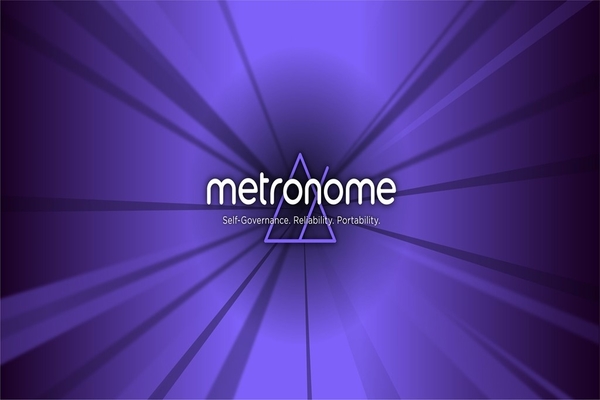
The idea of people’s money for the people has long been in pursuit by many, most have failed the test of integrity and suffered from the flaws in their foundations. Others, that see only a glimpse of success, have been taken over or crushed into pieces by the higher-ups as whoever controls the money, controls the world. Breaking away from the idea other cryptocurrencies have been entrapped with, Metronome (MET) learned from those who came before and committed to take the world of decentralization a step further.
Metronome was designed in 2017 by Bloq, a U.S. blockchain technology company, with the sole purpose of providing a long-term monetary system. The authors of the project are focused on making MET tokens truly decentralized by removing the company’s power over the project after the initial launch. Ultimately, this will allow the users to take full control over their MET tokens and put their trust in the code instead of a company.
Self-Governance Autonomous Cryptocurrency
The mystery of the Bitcoin creator is probably one of the main factors contributing to its success. To truly create something borderless, no one should helm a cryptocurrency as it negates the benefits of decentralization.
Similar to what Satoshi Nakamoto has achieved, Metronome made autonomy one of its core properties. Bloq boasted “zero founder control” as they rely solely on the smart contacts overseeing the governance of the system in 2018 after its launch. To strengthen the sense of co-ownership, Bloq has published the “owner’s manual” indicating that every MET user is ensured to have full control over their tokens.
Like Clockwork
Metronome is built to last, unlike the deflationary property of Bitcoin and other cryptocurrencies, where the supply limit can cause instability after the last coin is mined. Due to the nature of deflation, it discourages people from spending and investing because their assets are more likely to go up in value over time.
The major flaw of fiat currency is that there are no strict rules on how much and when the new supply will be created and injected into the system. The centralization of power in the hands of the selected few are also deemed to be the problem. While MET has unlimited token supply like the fiat, but in this case, the inflation is hardcoded and controlled by the smart contracts thus making it predictable.

Every 24 hours, new supply of MET tokens is minted and put up for an auction to the public. This resupply is all controlled autonomously by smart contracts and distributed via a descending price auction system. This means that every 60 seconds, the auction price will decrease to 99% of previous price. The auction continues until the entire daily supply is sold or it reaches the end of a 24-hour period and any remaining MET will be added to the next day’s supply lot.
This method of daily resupply auction gives equal accessibilities to everyone, enables daily price discovery, and ensures that there will always be enough MET for the public to use as a medium of exchange. As mentioned before, MET supply is unlimited but the mintage of new MET tokens is hardcoded to keep the inflation in check. At this time, 2,880 new MET are sold via the daily auction. Once that 2,880 represents a 2% inflation rate, it will adjust to maintain that inflation rate ad infinitum.
Beyond a Decentralized Payment System
As authors of MET do not have access and control to the system, the system automatically adds the auction proceeds into a Proceeds contract — a locked box that no team member can withdraw from. At the end of each 24-hour auction period, 0.25% of the proceeds are sent to the Autonomous Converter which will be used to provide liquidity for the community. In a way, this converter acts like DeFi (Decentralized Finance) application that allows MET owners to convert between MET and its residing chain’s native token at any time without any human intermediaries.
Metronome was originally built as an institutional-grade means of payment. This autonomous decentralized monetary system also supports mass-pay and recurring subscription payments with a fast on-chain settlement time of a mere 15 seconds, however, this may vary depending on the underlying blockchain that the token resides in.
The teams of authors and community supporting Metronome are currently researching a way to enjoy the tokens’ unique properties which could open new doors to extend its DeFi’s arm. Integrating autonomy to decentralization will make DeFi much more viable and could unlock a whole new dimension of possibilities, and it would not be an overstatement that this could lead to something far beyond what we are currently capable of.
Cross-Chain Portability Made Simple
To achieve the greatest level of endurance and flexibility, Metronome also allows users to send MET tokens between different blockchains. The cross-blockchain portability dubbed “chainhop” adds an extra degree of control as users can choose which blockchain best suits their requirements and will govern their tokens.
The process of hopping between chains is simple and effective. When the MET token holder exports a token, the source chain creates a receipt which captures all transaction details and then proceeds to burn the tokens. The token holder can then redeem the receipt and claim the token ported to the destination chain. This method eliminates the risk created by volatility and exchange rate difference.
Currently, the MET tokens are capable of hopping between Ethereum and Ethereum Classic chains. The Qtum and Bitcoin’s RSK chainhops have long been discussed are in the development by the community and could be launched later this year.
Usability: Metronome Wallets & Exchanges
The Metronome Wallet is available on Mac, Windows, Linux, iOS, and Android. Users can enjoy the full functionality of what Metronome has to offer with built-in auction , autonomous converter, and chainhop portability functionality. Metronome is also compatible with Edge Wallet, Argent, QoinPro and hardware wallets like Ledger.
In case you do not want to spend time waiting until 12:00UTC for the daily auctions to begin, cryptocurrency exchanges like Hotbit and Bittrex are offering MET/ETH and MET/BTC trading pairs.
The Verdict
Metronome gives us a fresh take in the space as the autonomous attribute takes the decentralized nature of cryptocurrency to the next level. While many projects have boasted a similar concept, few have succeeded and the key lies in execution. For MET, the team seems to have been very active on their platforms and in updating their community of the developments. The community is also active on their channels, which reflects a real and targeted interest in community development.
The project has not forsaken the ‘currency’ part of cryptocurrency like many others. The core idea of the project to create a viable and reliable payment method is still very much intact and promising. Contrary to what most people think, inflation is not necessarily a bad thing as it promotes investment and growth, especially with the predictable inflation rate of the MET tokens which help investors calculate and project the future much easier.
The descending price auction provides fair access to the token for everyone as well as enabling price discovery. The smart contracts overseeing the token economy adds a layer of transparency while ensuring users that speculation and manipulation of the token’s prices are being kept at bay.
The lack of trading volume on exchanges is being compensated for by the built-in Autonomous Converter, which provides on-demand liquidity to the owners allowing them to switch in-and-out of MET at any time.

Cross-chain portability is much welcomed as it gives token owners a sense of absolute freedom to choose which ledger will govern their tokens. This ability to move freely adds a degree of resilience as the tokens are not permanently tied to any blockchains in case of attacks or other unfortunate events. However, the chainhop still needs validators to validate ‘receipts’, this may raise the question on the long-term sustainability of incentivizing validators who are relying solely on the fees to continue doing their jobs if porting activities are being minimized overtime.
The community behind Metronome is relatively strong as new developments continue to be rolling out. The 2nd phase of cross-chain portability to the Bitcoin’s RSK and Qtum are set to be launched this year, while the authors are researching possibilities on EOS and Cardano as well.
If you want to learn more about Metronome, visit their website.


